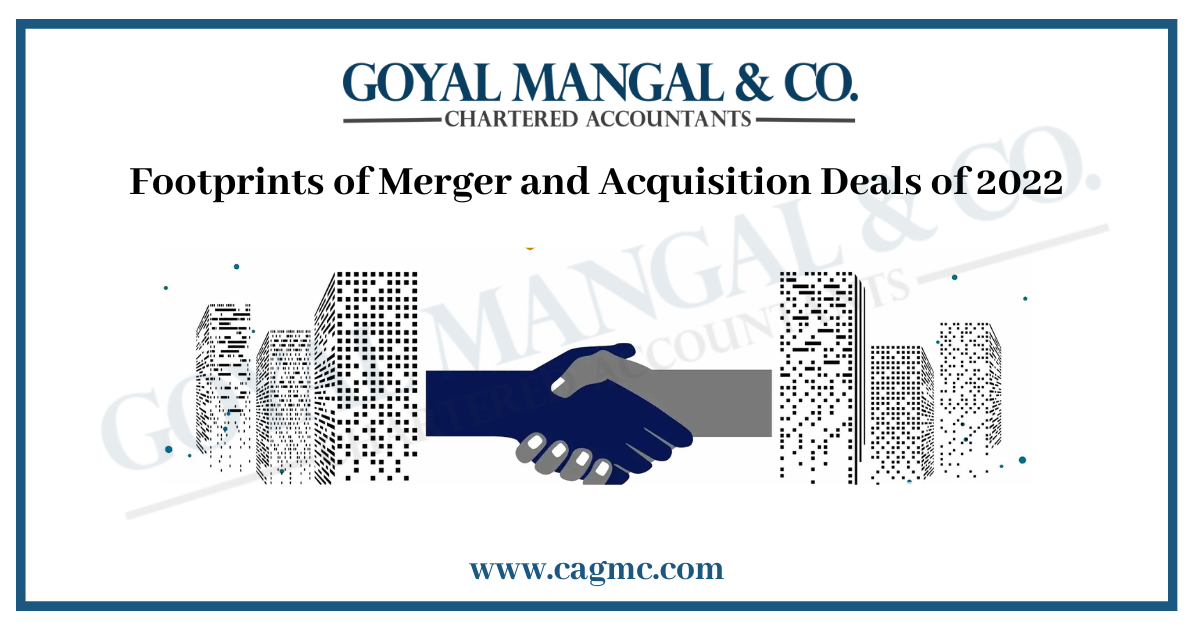
Mergers and Acquisitions (M&A) have become a vital part of the Indian corporate landscape, with many businesses looking for growth through consolidation. India has witnessed an increase in M&A activities in recent years, and the trend is likely to continue in 2022. In this article, we will explore the footprints of Merger and Acquisition Deals of 2022 in India, including trends, challenges, and opportunities.
Short Glimpse
The corporate world has long involved Mergers and Acquisitions (“M&A”) to gain competitive advantage and ultimately increase shareholder value. Companies must make frequent decisions about these measures in today’s dynamic economic environment; after all, the goal of management is to maximize shareholder value. Most Indian companies have opted for mergers and acquisitions to expand in the current market as the country’s industries have become more vulnerable to both domestic and foreign competition, and competitiveness has become critical to their survival.
The main objective of most Indian Companies is to influence and profit from global consumers. This global influence on consumers can be achieved by partnering with other existing or newly established businesses both domestically and internationally. M&A has proven to be a comprehensive method for expanding the company’s creation portfolio; penetrating new markets, learning, increasing access to research and development, and gaining access to the resources that enable the company to operate globally.
In all economic sectors, including information technology, research and development, pharmaceuticals, infrastructure, energy, consumer retail, media and telecommunications, financial services, and hospitality, India is growing rapidly and rising to the top.
What is Merger?
Legally, a merger requires two companies to merge into a new entity with a new ownership and management structure (ostensibly with members of each firm). A more common distinction in differentiating a deal is whether the purchase is friendly (a merger) or hostile (an acquisition). Mergers don’t require any cash to complete, but they dilute each company’s individual strength.
In practice, friendly mergers of equals do not happen very often. It is unusual for two companies to benefit from joining forces with two different CEOs agreeing to relinquish some power in order to realize those benefits. When this happens, the shares of both companies are surrendered and new shares are issued under the name of the new business identity.
What is Acquisition?
An acquisition does not create a new company. Instead, the smaller company is often consumed and ceases to exist, and its assets become part of the larger company.
Acquisitions, sometimes called takeovers, generally have a more negative connotation than mergers. As a result, acquiring companies may refer to an acquisition as a merger, even though it is clearly a takeover. An acquisition occurs when one company takes over all operational management decisions of another company. Acquisitions require large amounts of cash, but buyer power is absolute.
Companies can get another company to buy their supplier and improve economies of scale, reducing unit costs as production increases. Companies may seek to improve their market share, reduce costs, and expand into new product lines. Companies engage in acquisitions to acquire the target company’s technologies, which can help save years of investment costs and research and development.
Benefits of Merger and Acquisition
Some benefits of mergers and acquisitions have to do with efficiency, while others have to do with capabilities, such as:
- Improved economies of scale. Thanks to the possibility of buying raw materials in larger quantities, costs can be reduced, for example.
- Increased market share. Assuming the two companies are in the same industry, pooling their resources can lead to greater market share.
- Expanded distribution options. Through geographic expansion, companies may be able to add to their distribution network or expand their geographic service area.
- Reduced labor costs. Eliminating layoffs can help reduce costs.
- Improved work talent. Expanding the pool of labor that a new, larger company can draw on can help growth and development.
- Expanded financial resources. The funds of two companies are generally higher than one alone, which allows for new investments.
Reasons for Merger and Acquisition Activity
Below are some of the listed reasons for Merger and Acquisition Activity
- Release of Synergies: A common reason for Mergers and Acquisitions (M&A) is to create synergies so that the combined company is worth more than either company alone. Synergies can result from cost reductions or higher revenues.
Cost synergies are created through economies of scale, while revenue synergies are typically created through cross-selling, increasing market share, or raising prices. Of the two, cost synergies are easily quantified and calculated. - Higher Growth: Inorganic growth through mergers and acquisitions (M&A) is usually a faster way for a company to achieve higher revenues compared to organic growth. A company can gain by acquisition or merger with a company with the latest capabilities without having to take the risk of developing internally.
- Stronger Market Power: In a horizontal merger, the resulting entity gains a higher market share and the power to influence prices. Vertical mergers also lead to greater market power because the company will have more control over its supply chain, avoiding external supply shocks.
- Diversification: Companies that operate in cyclical industries feel the need to diversify their cash flows to avoid significant losses during a downturn in their industry. Acquiring a target in a non-cyclical industry allows a company to diversify and reduce its market risk.
- Tax Benefits: Tax benefits are assessed where one company realizes significant taxable income while another incurs a tax loss from prior years. Acquiring a tax-loss company allows the acquirer to use the tax losses to reduce its tax liability. However, mergers are not usually done just to avoid taxes.
What is involved in an M&A Deal?
The process of preparing and executing an M&A can be challenging. Months can be spent evaluating potential target companies with a thorough due diligence review of their material information. This deep dive into their data—financial, business, operational, and more—is essential to understanding the current state of the company and whether the business will be financially viable. If you’re on the sell side, you can learn more about what goes into a successful exit in our Business Exit Center.
M&A typically begins with a preliminary evaluation of the target company, including high-level discussions between the buyers and sellers to explore how the two companies could be strategically linked, how their values align and what potential synergies could be realized.
At the beginning of the due diligence process, a lot of preliminary work needs to be done in evaluating the market, business and financial reports.
Once the parties move into formal due diligence using data room software, the process involves an intensive question-and-answer period and the delivery and verification of all critical documentation to highlight potential risks or gaps along with key opportunities. Security is paramount throughout the transaction process, and the risk of disclosure can lead to transaction failure and damage to personal and professional reputations.
Key steps in an M&A deal include:
- Preliminary Negotiations and Nondisclosure Agreements
- Goal assessment and evaluation
- Due diligence in the virtual data room
- Signing the contract and closing the deal
- Integration by agreement
Trends in M&A Deals in India in 2022
The M&A landscape in India is evolving, and the year 2022 is expected to witness some significant trends. One of the notable trends is the increasing focus on digital transformation. Many businesses are looking to acquire or merge with tech-focused companies to stay competitive and meet the evolving needs of customers.
Another trend is the focus on sustainable and responsible business practices. Many companies are looking to acquire or merge with firms that have strong environmental, social, and governance (ESG) practices. This trend is likely to continue as companies become more conscious of their impact on society and the environment.
Challenges in M&A Deals in India in 2022
While M&A deals offer many benefits, they also come with challenges that businesses need to address. One of the biggest challenges in India is the regulatory environment. India has complex regulations that can make it difficult for companies to navigate the M&A process. Additionally, there is a lack of clarity in some regulations, which can lead to delays and uncertainty.
Another challenge is cultural differences between companies. Merging two companies with different cultures can be a significant challenge. Companies need to invest time and resources in understanding the culture of the other company and finding ways to align them.
Footprints of Significant M&A deals from the year 2022
Let’s review the footprints of significant M&A deals from the year 2022:
- Acquisition of Air India by Tata Group: After successfully bidding INR 180,000,000,000 (eighteen thousand rupees only) for a 100% stake in Air India, Tata Group acquired Air India (AI) through its subsidiary Talace Private Limited (TPL) in January 2022. Given that Tata Group also owns a majority stake in AirAsia India (AAI) and Vistara, a joint venture with Singapore Airlines (SA), this acquisition may be part of Tata Group’s overall aviation business strategy.
With an estimated completion date of 2024, the Tata group is set to begin the process of unifying all its airline operations under the “Air India” brand. Currently, the Tata Group majority owns four airlines: AI, Air India Express (AIE), Vistara, and AAI. Along with AI, Tata Group also bought a 50% stake in Air India’s ground handling company, SATS Airport Services Pvt. Limited (AISATS), and AIE, AI’s wholly-owned low-cost subsidiary operating in the international short-haul market.
The Tata Group owns an 83.67% stake in AAI and a majority 51% stake in Vistara, with Malaysia-based AirAsia Berhad owning 16.33% of the former and 49% of the latter. As part of consolidating its airline portfolio, the Tata Group has decided to buy AirAsia Berhad’s stake in AAI for $30 million.
- The merger of ZEE Entertainment and Culver Max Entertainment: The merger of Zee Entertainment Enterprises Limited (ZEEL) and Culver Max Entertainment, formerly Sony Pictures Networks India Pvt. Ltd., India’s two largest media companies, is expected to be worth multi-billion dollars. The board of directors of ZEEL has approved the merger of the two companies, which has the potential to make the combined entity one of the most prestigious and prominent in India.
In a joint statement issued in December 2021, ZEEL and SPNI said the Japanese corporation would hold 50.86% of the merged entity, while ZEEL’s promoters would hold 3.99%, and public shareholders would hold the remaining 45.15%. ZEEL’s underwriters will receive a non-compete fee from SPNI as part of the deal, which they will use to inject primary equity into SPNI and purchase shares in the company.
These shares would ultimately represent approximately 2.11% of the combined entity’s shares. Although ZEEL still lacks financial support for its expansion goals, the merger of ZEEL and SPNI will increase the combined entity’s access to cash flow and financial strength. Revenue synergies from the merger of ZEEL and SPNI will be reflected in the combined entity’s fiscal 2023 earnings call. Most of the expected synergistic benefits will come from advertising revenue, while synergies in subscription revenue will depend on the new tariff TRAI expects to release in the near future.
- The merger of PVR with INOX: The plan of merger involving PVR Limited (PVRL) and Inox Leisure Limited (INOXL) was accepted by the boards of directors of PVRL and INOXL in March 2022. In a filing with the regulatory authorities, PVRL said it would seek approval from the shareholders of its own capital with the INOXL merger at the general meeting on October 11, 2022.
At the general meeting, 99.9986% of votes were cast in favour of the merger and 0.0014% of votes against. Pursuant to the merger plan, INOXL shareholders will receive PVRL shares in exchange for INOXL shares at the agreed exchange ratio, viz., 3 shares of PVRL are exchanged for 10 shares of INOXL at this share exchange ratio.
After the merger, along with the current promoters of PVRL, the promoters of INOXL will become co-promoters of the merged entity. According to a regulatory filing dated March 27, 2022, the board of the merged entity would be reconstituted after the merger with a total strength of 10 members and equal representation of both promoter families on the board, each with 2 seats on the board.
- Adani’s acquisition of Ambuja and ACC Cements: The transaction with the Swiss company Holcim and an open offer were completed in September 2022 by the Adani family through their special-purpose vehicle, Endeavor Trade and Investment Ltd. (ETHYL).
In compliance with SEBI regulations, the transaction involved an open offer and the acquisition of Holcim’s stake in Ambuja Cement Limited (ACL) and ACC Limited (ACCL). Holcim’s equity and open consideration for ACL and ACCL total $6.50 billion, making this ETIL’s largest acquisition and the largest M&A in India’s infrastructure and materials history. Following the purchase, ETIL will own 56.69% of ACCL and 63.15% of ACL (of which 50.05% is held through ACL).
With extensive manufacturing and supply chain infrastructure, both ACL and AACL are among the strongest in India. They have 14 integrated units, 16 grinding units, 79 ready-mix concrete plants, and more than 78,000 distribution partners spread across India.
Opportunities in M&A Deals in India in 2022
Despite the challenges, M&A deals offer many opportunities for businesses in India. One of the biggest opportunities is the potential for growth. M&A deals can help businesses expand their reach, enter new markets, and diversify their offerings.
Another opportunity is the potential for cost savings. By merging with or acquiring another company, businesses can achieve economies of scale and reduce costs. This can help companies become more competitive and improve their bottom line.
Conclusion
In fact, the reason for mergers and acquisitions is that both companies are more valuable and more profitable than the individual companies, and the shareholder value is also greater than the sum of the two companies. Despite negative studies and opposition from economists, MandA continues to be an important tool for company growth. The reason is that the expansion is not limited by internal resources; there is no outflow of working capital; the exchange of shares can be used; it is attractive as a tax advantage; and above all, it can consolidate the industry and increase the market power of the company.


